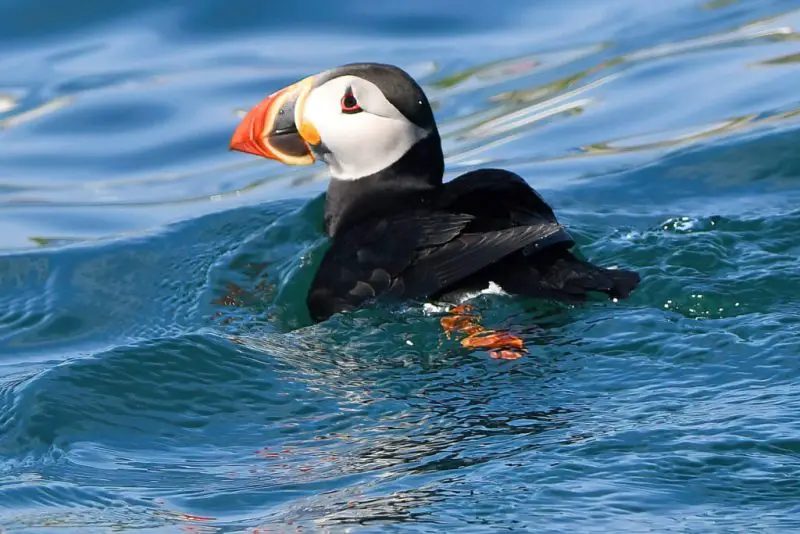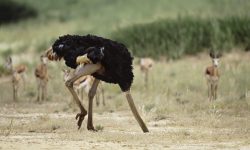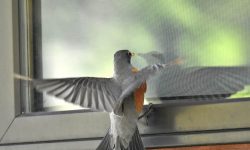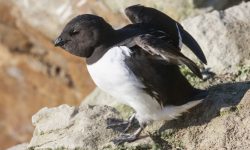The Atlantic Puffin (Fratercula arctica) is more than just a photogenic seabird with a bright beak and comical expression. Beneath its charming appearance lies a species finely tuned to survive in the harsh and fluctuating environments of the North Atlantic. From its high-efficiency hunting techniques to complex mate selection behavior and vulnerability to climate change, the puffin offers a rich case study in evolutionary adaptation and ecological sensitivity.

Morphological Adaptations: Designed for Dual Environments
Streamlined for Air and Water
Unlike most birds, Atlantic Puffins are highly adapted for efficient locomotion in both air and water—two radically different physical environments. Their wings are short and rigid, which at first glance seems inefficient for flight. However, this structure is ideal for functioning as hydrodynamic flippers underwater, allowing puffins to “fly” through water with remarkable speed and control.
In the air, they compensate for their small wingspan with extraordinarily fast wing beats—up to 400 beats per minute. This results in short, fast flights, which are energetically costly but effective for rapid takeoffs and dodging predators near cliffs.
Beak Structure and Seasonal Morphology
One of the puffin’s most iconic features—the colorful beak—is also seasonally modified. During the breeding season, hormonal changes trigger the development of bright orange and yellow keratinous plates on the beak. After breeding, these plates shed, and the beak becomes duller and more streamlined—an energy-saving adaptation for the long non-breeding period at sea.
Moreover, the beak is functionally specialized: the inside contains serrated spines and a rough tongue, which allow puffins to grip and hold multiple fish simultaneously, often aligning them in parallel rows across the beak. This is a morphological innovation that gives the puffin a feeding advantage among diving seabirds.
Feeding Ecology: A Predator of Pelagic Fish
Foraging Behavior and Visual Hunting
Puffins feed almost exclusively on small schooling fish, including capelin, herring, and sand lance. Their foraging behavior is visually guided, requiring clear water and well-lit conditions. They typically forage at depths of 10–30 meters, using their wings to propel and steer, while the eyes adjust focus underwater—an ability rare among birds.
They exhibit prey-loading behavior, in which they collect several fish per dive and bring them back to the nest. This behavior is energetically efficient for central-place foraging during chick-rearing, and success is closely tied to local fish abundance and distribution, making puffins highly sensitive to shifts in marine food webs.
Trophic Role and Ecosystem Monitoring
As mesopredators, puffins occupy a mid-level trophic niche and act as sentinels of marine ecosystem health. Changes in their diet composition or foraging range can indicate broader shifts in ocean temperature, fish migration, and prey availability. In regions like the Gulf of Maine, puffins have been used to monitor ecosystem responses to ocean warming.
Breeding Biology: A Life Built on Loyalty and Precision
Monogamy and Nest Fidelity
Atlantic Puffins are long-lived seabirds (up to 30+ years) and demonstrate strong mate and site fidelity. Pairs often reunite each year at the same burrow site. This fidelity reduces the time and energy needed to find a mate or suitable nesting ground, giving puffins an early advantage in the breeding season.
Reproduction Under Constraint
With only one egg per season and a long rearing period, puffin reproductive success is highly dependent on prey availability. If local fish stocks collapse or become energetically less profitable (e.g., smaller size or lower fat content), puffin chicks may suffer from starvation or developmental delays.
Interestingly, puffins typically feed chicks one fish at a time, unlike gulls that regurgitate food. This limits feeding rate and creates a tight coupling between adult foraging success and chick survival.
Social Behavior and Communication
Colony Dynamics and Burrow Defense
Puffins nest in dense, often chaotic cliffside colonies, where hundreds to thousands of birds converge during the breeding season. Each pair excavates a burrow—typically in grassy slopes or soft soil—and defends it vigorously. Given how close nests are to one another, aggressive encounters are inevitable, yet puffins have evolved complex social behaviors to reduce direct conflict.
Territorial defense begins with visual signals. A puffin returning to its burrow will often bob its head rhythmically, puff out its chest, and spread its wings slightly—behaviors that serve as both warnings to intruders and recognition cues for the mate. When threatened, puffins may also vocalize low growls or grunts from within the burrow to deter nearby individuals.
These signals are especially important because puffins cannot rely on brute force alone—physical fights can be costly. Instead, they engage in ritualized posturing that allows disputes to be resolved quickly, preserving energy for breeding and chick care.
Pair Bonding and “Billing” Rituals
Among the most iconic social behaviors is billing—a mutual display where bonded mates rhythmically rub or clash their beaks together. This behavior occurs most frequently near the burrow and serves multiple purposes: it reinforces pair bonds, signals reproductive cooperation to the colony, and helps re-establish intimacy after a long winter spent apart at sea.
Billing is not random. It’s most intense early in the breeding season and often accompanied by synchronized body movements, suggesting a strong emotional and hormonal basis. These displays are believed to play a critical role in maintaining monogamy, as puffins typically reunite with the same partner each year.
Social Hierarchy and Spatial Memory
Despite their dense colonies, puffins exhibit a form of spatial organization. Each individual remembers its burrow location with great accuracy, using visual landmarks and likely olfactory cues. This precision reduces confusion in crowded spaces and may help prevent territorial overlap.
Interestingly, puffins also exhibit a rudimentary social memory—recognizing familiar neighbors and adjusting behavior accordingly. Birds nesting beside the same individuals year after year may show less aggression toward them, suggesting some degree of social tolerance that stabilizes the colony over time.
The Role of Vocal Communication
Though puffins are relatively quiet at sea, they become far more vocal during the nesting season. Inside burrows, mates use a repertoire of low growls, croaks, and purr-like sounds to communicate. These vocalizations likely serve to strengthen the bond between partners and coordinate parental duties, such as switching incubation shifts or feeding schedules.
Together, these complex behaviors reveal that puffin colonies are not chaotic crowds, but finely tuned social systems. Through a mix of ritualized displays, vocal cues, and long-term pair bonds, puffins reduce conflict, enhance cooperation, and ensure the survival of their young in one of nature’s most crowded bird nurseries.
Environmental Pressures and Population Vulnerability
Climate Change and Prey Mismatch
Atlantic Puffins are increasingly struggling with distributional shifts and reproductive failure linked to rising ocean temperatures. One of the most critical issues is trophic mismatch—a disruption in the timing between puffin chick hatching and the peak abundance of suitable fish prey.
As ocean waters warm, key forage species like sand lance and herring now spawn earlier in the season. However, puffin breeding cycles have not fully adjusted, meaning chicks often hatch after the best food sources have declined. In some years, adults return to the nest with nutritionally inferior fish, such as butterfish, which are too large or energy-poor for chicks to consume. The result is widespread chick starvation, even in otherwise healthy-looking colonies.
This mismatch may not cause dramatic die-offs in a single season, but over time it leads to lower breeding success, slower population growth, and gradual colony decline—particularly at the southern edge of their range, where environmental shifts are most pronounced. As ocean warming intensifies, these subtle yet systemic failures could tip vulnerable puffin populations past recovery thresholds.
Anthropogenic Threats
Beyond the growing pressures of climate change, Atlantic Puffins face an array of human-related threats that further jeopardize their survival:
Bycatch in Fishing Gear
Puffins are vulnerable to accidental capture in gillnets and trawl nets, especially when foraging close to fishing activity. These entanglements can lead to drowning, particularly during the breeding season when adult puffins make frequent trips between sea and nest.
Plastic Ingestion
Both adult puffins and their chicks frequently mistake floating plastic debris for small fish or squid. Ingested plastic can block the digestive tract, reduce appetite, or leach harmful chemicals, ultimately weakening the bird or leading to death.
Oil Spills and Pollution
Oil-coated plumage loses its waterproofing ability, leaving puffins at risk of hypothermia and drowning. Ingesting oil while preening also leads to internal poisoning. Even small spills near coastal colonies can have outsized impacts during breeding season.
Disturbance and Habitat Erosion
Coastal tourism and cliffside recreation can lead to nest abandonment, especially in high-traffic puffin colonies. Foot traffic and development also contribute to erosion of fragile nesting slopes, increasing the risk of burrow collapse and chick mortality.
Together, these threats illustrate the urgent need for comprehensive conservation measures that extend beyond climate mitigation to include sustainable fishing, marine pollution control, and the protection of coastal breeding habitats.
Conservation Outlook: The Edge Between Charm and Crisis
The Atlantic Puffin (Fratercula arctica) is currently classified as Vulnerable by the International Union for Conservation of Nature (IUCN), reflecting serious declines in many parts of its range. Although Iceland remains a stronghold—home to over half of the world’s population—other regions tell a more troubling story. Colonies across the British Isles, the Faroe Islands, and eastern Canada have seen dramatic drops in breeding success and overall numbers.
These declines stem from a combination of environmental and human pressures. Overfishing has reduced populations of small forage fish like sand eels and herring—critical puffin prey during chick-rearing. At the same time, warming ocean temperatures are shifting fish distributions, pushing food sources farther from traditional breeding sites and increasing the energy cost of foraging.
Extreme weather events, particularly heavy rainfall during nesting season, can flood burrows or chill exposed chicks, while predation by invasive species—such as rats or foxes introduced to puffin islands—can devastate entire colonies. Coastal erosion and habitat loss further compound the problem.
In response, a range of targeted conservation efforts are underway:
-
Marine protected areas are being established to safeguard essential feeding zones, reducing the risk from fisheries and disturbance.
-
Fishery regulations aim to ensure sustainable management of puffin prey species, especially sand eels.
-
On eroding nesting cliffs, conservationists have begun installing artificial burrows to provide safe, stable nesting sites that mimic natural conditions.
-
Long-term monitoring programs track population changes, breeding success, and foraging behavior, providing vital data to guide adaptive management.
These efforts are making a difference in some regions, but they require international cooperation and sustained support to be effective. With puffins spending most of their lives at sea and migrating across borders, protecting this iconic seabird demands a broad, ecosystem-based approach. The future of the Atlantic Puffin will depend not only on protecting nesting sites but also on restoring the health of the oceans they call home.
Conclusion: More Than a Cute Seabird
The Atlantic Puffin’s colorful beak and cartoonish appearance hide a story of remarkable biological engineering and environmental sensitivity. It is a species shaped by evolutionary pressures both ancient and immediate—driven by the demands of marine life and now strained by climate disruption.
To understand and protect puffins is to understand the deep interdependence between seabirds, ocean ecosystems, and human action. They are not just a symbol of northern coasts, but a living barometer of the health of our planet’s seas.






